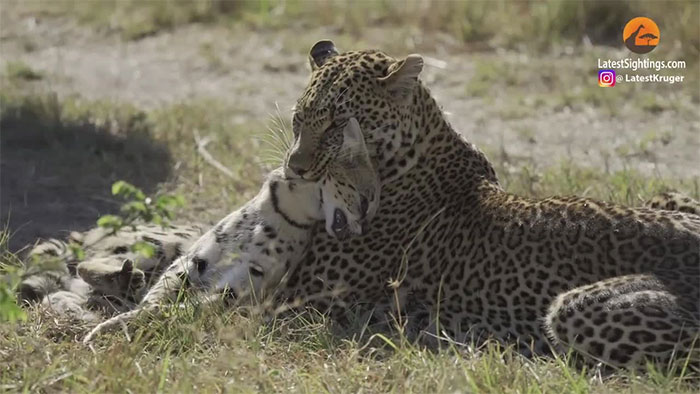Despite having speed on its side, the serval is swiftly taken down by the African leopard.
The moment an African leopard ruthlessly takes down a serval was captured by 26-year-old nature photographer Valentin Lavis during his trip to the Masai Mara National Reserve in Kenya.

The African leopard grips the serval’s neck and does not let go.
The clip shows the moment the African leopard silently approaches a serval, and when the distance is close enough, the leopard lunges to seize its prey. Despite its speed advantage, the serval is caught off guard by the leopard’s sudden attack and is quickly dispatched by the predator.
“We spotted a female leopard hunting. Initially, the leopard noticed a few antelopes in the tall grass, but suddenly it changed its mind and began stalking something in the dense bushes,” shared Valentin Lavis. “In just a second, the leopard sprang out to attack its target, which was a serval.”
“The African leopard clamped down on the serval’s neck and would not let go. The serval struggled in pain to escape from the predator, but unfortunately, it eventually succumbed to the powerful jaws of the African leopard,” Lavis added. “This is one of the most brutal scenes I have ever witnessed in my life, but this is how the wild operates; only the strong survive.”
The African leopard takes down the serval in the blink of an eye (Video: Latest Sightings).
The serval is a medium-sized cat, slender in appearance, with long legs and a relatively short tail. The weight of a serval ranges from 7 to 12 kg for females and 9 to 18 kg for males.
Servals are solitary animals and primarily hunt at night. They typically eat rodents, birds, hares, reptiles, fish, frogs, and occasionally hunt larger animals like antelopes. The serval is an excellent predator thanks to its large ears with exceptional hearing, capable of reaching speeds of up to 80 km/h and jumping 2 to 3 meters high to catch birds.
Meanwhile, the African leopard (also known as the African spotted leopard) is one of the five big cat species (which include tigers, lions, jaguars, leopards, and cheetahs). An adult male can weigh between 60 and 91 kg, while an adult female can weigh between 45 and 60 kg.
Although not as fast as the cheetah, the leopard remains a dangerous and fearsome predator due to its stealthy approach to prey. The diet of the African leopard can include rodents, antelopes, deer, birds, and primates.
Thanks to its stalking ability and skilled hunting techniques, the leopard is considered the most successful feline species in the natural world.


















































